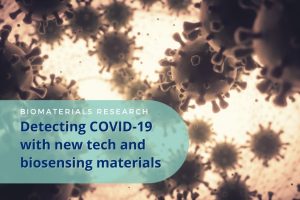
Researchers in the lab of department chair and faculty member Howard Katz have developed a method of identifying and monitoring SARS-Cov-2 (COVID-19) proteins and antibodies in samples using a new device for electrical measurements and semiconducting polymers.
Recently published in the American Chemical Society’s journal, ACS Applied Nano Materials, the project started at the beginning of pandemic when university researchers were encouraged to look for ways to solve the many challenges the novel coronavirus presented as it began to spread throughout the world. Katz and his team were just one of several teams who were tasked with how to recognize COVID-19 proteins for future testing and monitoring.
In the study, the team used a recently developed type of semiconductor device called an organic electrochemical transistor (OECT) to determine what types of semiconducting polymers could indicate the presence of COVID-19 proteins. Compared to traditional devices, the OECT is capable of amplifying the electrical signal needed for this type of biosensing because of its function resembling that of a transistor. The team covered the channel region where current can be switched with a layer of semiconducting materials capable of covalently linking to antibodies and proteins.
“The SARS-CoV-2 antibody and its antigen will bind in a specific way at the molecular level,” said second year PhD student and a co-author, Yunjia Song. “Once they bind, the charge of the biomolecules will be changed, which we can then detect.”
The results indicate a potential of a rapid detection of the COVID-19 virus. These results could help facilitate future work to design active materials, electrical circuits, and testing conditions to increase the signaling provided by biosensors. The team focused mainly on the antibody itself and the interactions between antibody and the protein on the outside of the virus’s molecular structure, but Song is hopeful their work will inspire more research and eventually result in a commercially used biosensor.
“We know our configuration works in the lab and on clinical samples,” said Song. “It’s exciting to think it could be used in the real world to detect COVID-19 and COVID antibodies someday.”
Song says she and the team are already looking for another version of the set up they created with the OECT and semiconducting polymers in this study to make the device more sensitive, but all are thrilled to have played a part in the fight against COVID-19.
“I’m grateful we were able to contribute to deepening the scientific community’s fundamental understanding of how biosensing materials can be used to detect the virus,” said Katz.
Read Nanoscale Bioreceptor Layers Comprising Carboxylated Polythiophene for Organic Electrochemical Transistor-Based Biosensors
DOI: 10.1021/acsanm.1c02949
Biomaterials Research at MatSci
For more projects related to biomaterials, visit our research page.
